
Located within El Yunque National Forest in Puerto Rico, the Fish and Wildlife Service's Iguaca Aviary is at the center of efforts to expand and rehabilitate the population of critically endangered Puerto Rican parrots. After hurricanes heavily impacted El Yunque in 2017, Forest Service staff in El Yunque reached out to FEMP and NREL for technical assistance support in improving the resilience of El Yunque and the Iguaca Aviary within it.
El Yunque National Forest in Puerto Rico is unique for many reasons: While it is the smallest national forest, it is among the most biologically diverse, and is the only tropical rainforest in the U.S. National Forest system. Like every federal facility, it also has unique, site-specific conditions that must be carefully considered to implement the best possible renewable energy and battery energy storage system.
When El Yunque sought to implement onsite solar photovoltaics (PV) and battery storage for the Fish and Wildlife Services' Iguaca Aviary that is within the forest, they leveraged Federal Energy Management Program (FEMP) technical assistance, direct site and agency funding, and support from the National Renewable Energy Laboratory (NREL) to evaluate their renewable energy and energy storage potential.
Planning: Assessing PV and Storage Potential with REopt
NREL engineers worked with the site team to gather site energy data, and then conducted a site visit to view the facility, meet with staff, and identify normal and critical (grid failure) loads (e.g., loads that must continue to be powered in the event of a grid failure). Using the information collected, NREL used the REopt® web tool, a techno-economic modeling and optimization tool for distributed energy systems, to assess the potential for cost-optimal solar plus storage for grid-connected electricity cost savings and resilience against grid outages. The results informed sizing and specifications for the proposed PV and storage system.
Implementation: Specifications, Contractor Selection, Construction, and Commissioning
NREL prepared design-build PV and battery specifications for use in a project solicitation. Specifications included requirements for battery operation during nominal and grid outage conditions. Because the site has recently experienced several hurricanes, the specifications included high wind resistant low-profile PV with eight bolted connection points per module.
Once a solicitation went out, NREL assisted with proposal reviews and best value selection, reviewing and providing comments on design submittals, attending construction meetings, providing support related to construction issues, and reviewing commissioning.
Project Benefits
El Yunque's new Aviary system offers energy security and savings, with PV and batteries now providing 100% of the energy to critical loads during daylight hours. The project also offers considerable resilience benefits, as the system provides energy to critical loads for several days in the case of grid failure. The grid failed for 5 days in September 2022 when Hurricane Fiona struck Puerto Rico. The Aviary PV and batteries system was not damaged and provided 100% of the energy needs for critical loads for 5 days.
Hurricane Fiona No Match for Fish and Wildlife Service's Solar and Battery MicrogridShortly after completion of commissioning, the Iguaca Aviary was hit by Category 1 Hurricane Fiona, but the PV and BESS were not damaged and carried 100% of the emergency loads for 5 days with no need for a backup generator. This project highlights the ways in which an appropriately sized, designed, and installed PV and battery storage system can save energy and provide improved resilience and maintain critical operations throughout a storm. |
Goals, Strategies, and Lessons Learned
- Customize the system to the local climate: Include technical specifications to harden the system against severe weather events.
- Leverage FEMP expertise and resources in planning: As part of FEMP support, NREL engineers supported the project from initial data collection and project feasibility assessment to deployment and operation. The team was able to help the site avoid potential issues by reviewing proposals and designs, and when issues arose, NREL was well-positioned to help the site troubleshoot.
- Consider critical loads in case of grid failure: After project implementation, noncritical loads were connected to the emergency panel without consulting NREL engineers or the contractor. These additional loads were too high for the solar-plus-storage system to support, so the system was not able to maintain critical operations during grid outages. The contractor switched these noncritical loads off the emergency panel and the system currently operates properly. It is important to avoid adding unnecessary loads on the emergency panel to ensure it can sustain critical loads in the case of grid failure.
- Review deviations from design specifications: The use of the emergency panel for noncritical loads illustrates how decisions that veer away from system design specifications should be reviewed before implementation.
- Specify PV and battery performance requirements during both grid-tied and grid outage conditions: For grid outages, specify the microgrid sequence of operations.
Additional Resources
Request technical assistance for federal distributed energy projects.
Create customized technical specifications for on-site PV systems.
Learn about severe weather resilience in PV system design.
- Verify contractor responsibility: Determine ahead of time who is responsible for battery and PV system operations and maintenance, capacity maintenance, and optimal battery dispatch for bill savings during grid-tied operations.
Tools and Resources
El Yunque partnered with FEMP, which offers technical assistance, technical analysis, and procurement support to federal agencies considering distributed energy resources.
As part of FEMP technical assistance, NREL experts evaluated the site's renewable energy and energy storage potential using REopt, a techno-economic decision support platform to optimize energy systems for buildings, campuses, communities, microgrids, and more. REopt can be used to identify the optimal mix of renewable energy, conventional generation, and energy storage technologies to meet cost savings, resilience, emissions reductions, and energy performance goals.

